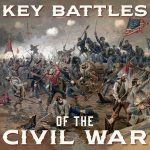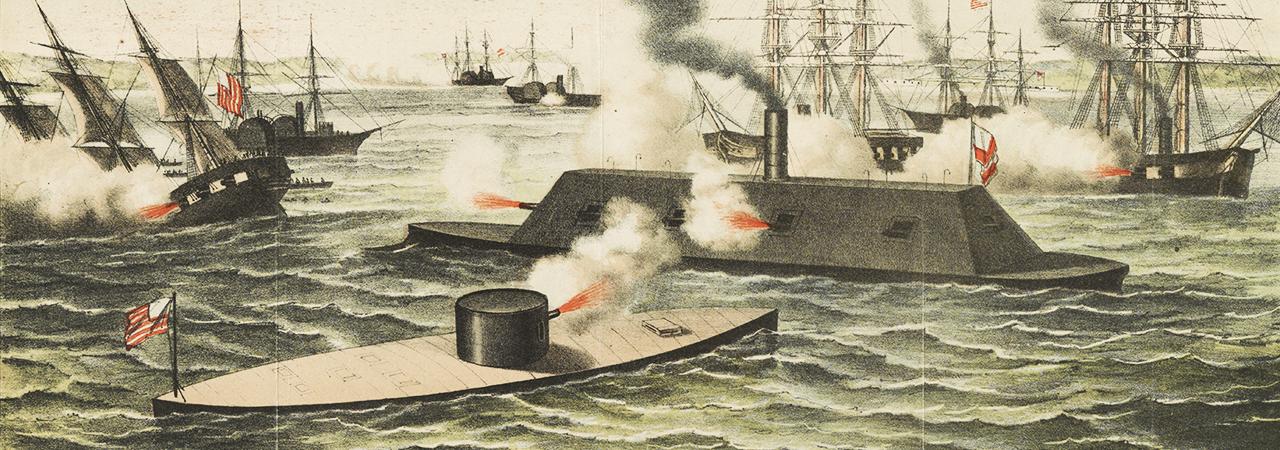Loading...
An aspect of the Civil War that few know about is the naval war. Learn how battles occurred on American Rivers, gulfs, shorelines, and even as far away as Alaska.
Background
- The Union Navy and its Strategy
-
-
- At the start of the war, the U. S. Navy only had about 90 ships, and only 42 of those were in U. S. ports.
- Despite this, the U. S. had great shipbuilding capacity.
- The Union also converted merchant ships into naval ships.
- By the end of 1864, the U. S. Navy had 671 ships in commission. Over 200 were steam ships and 70 were ironclads.
- By the end of the war, the U. S. Navy was the largest navy in the world. They had 65,000 sailors.
- Secretary of the Navy Gideon Welles reorganized the navy and made it much more efficient.
- The Navy’s goal was threefold: blockade the southern coast, capture key Confederate ports, and support the ground war using the rivers.
-
- The Confederate Navy
-
- The Confederacy had no navy at the start of the war. Only 237 Union naval officers resigned to join the Confederacy.
- The South had no shipyards or machine shops that could build steam engines big enough to power a ship.
- The South had only three naval yards: New Orleans, Pensacola, and Norfolk. (At Norfolk, the Confederates captured 2000 heavy guns and the U. S. Merrimack). By 1862, the Union had recaptured all of the naval yards.
- During the war, the Confederates converted or built 130 ships, including 37 ironclads (some of the latter had rams).
- The Confederate Navy tried to compensate for its numerical inferiority by technology:
- Torpedoes (mines) sank or destroyed 49 Union ships
- Torpedo boats (carried mines on projections)
- Submarine (first successful one): the Hunley. Two volunteer crews drowned. On February 16, 1864, the Hunley attacked a Union blockade ship with a torpedo, sank the ship, but then sank itself.
- Commerce Raiding (see below)
The Blockade
- The Blockade Begins
-
-
- Lincoln proclaimed the blockade in April 1861. At that time, the Union Navy had far too few ships to effectively blockade the southern coast, but as the number of ships increased, so did the effectiveness of the blockade.
- The first Confederate blockade runner was captured in May of 1861.
- By the end of 1864, there were 500 Union ships in the blockade.
- The Union blockading ships were originally based at Hampton Roads, VA, and Key West, FL. This was too far from many Southern ports. As a result, the Navy decided to seize key inlets.
- By the end of 1861, Union forces had captured Hatteras Inlet, Ship Island (off Biloxi, MS), and Port Royal, SC. This gave the Union a great supply depot and coaling station.
- The Union soon extended its control of the outer southern Atlantic coast down to St. Augustine, FL and up to Roanoke, North Carolina.
-
- The Monitor vs the Virginia
-
-
- The Confederates had captured the U.S.S. Merrimack, raised it, turned it into an ironclad, and renamed it the Virginia.
- The Virginia was sent to break up the Union blockade near Norfolk, VA. On its first day (March 8, 1862), it destroyed two Union vessels and damaged three others.
- The next day (March 9), the Virginia set out to do more damage, but it met the U. S. S. Monitor (describe it). The two ships fought to a draw off Hampton Roads.
-
- The London Times wrote: “Before the duel off Hampton Roads, the Royal Navy had 149 first-class warships. After the battle, it has just two.” Wooden ships were now obsolete.
-
-
- As the Union Army marched up the peninsula toward Richmond, the Virginia had to go upriver. Eventually, the water was too shallow, and the ship had to be scuttled.
-
- Further Union Successes
-
-
- The Union Army and Navy captured New Orleans on April 25, 1862.
- Mobile (August 5, 1864).
- Admiral Farragut bombarded the forts guarding the harbor.
- Then the Union vessels went into the harbor in single file.
- The first Union ship hit a mine.
- Farragut pulled his flagship into the lead position.
- When some of his officers warned him that there were mines (“torpedoes”) in the harbor, he replied “Damn the torpedoes! Full speed ahead!”
- Farragut had himself lashed to the ship’s main mast.
- Mobile itself was not captured, but the port was rendered unusable.
- Wilmington, NC, the last major Confederate port, fell in January of 1865.
-
- The Blockade’s Effectiveness
-
- By the end of the war, 1 in 2 Confederate ships were captured.
- About 8500 vessels got through the blockade, while 1500 were captured. (So only 15% were captured).
- The Confederacy managed to import 600,000 rifles, 600,000 pairs of shoes, millions of pounds of lead, food, and other supplies.
- Confederate blockade runners that did get through were fast but small and could not carry much cargo.
- But much more would have gotten through without the blockade (20,000 ships went into Southern ports in the four years prior to the war).
- Dr. Gallagher estimates that the blockade cut Southern commerce to 1/3 its prewar level.
The River War
- The Western Confederacy had several rivers that cut into it, offering the Union great invasion routes.
-
-
- The Mississippi
- The Tennessee
- The Cumberland
- The Union realized it would need a river fleet to take advantage of these watery invasion routes.
- The Confederacy built fortifications among all of them.
-
- Union River Vessels
-
-
- River boats had to have powerful guns to go against Confederate fortifications, but they had to have shallow drafts so that they could float in as little as 10 feet of water.
- The first set of Union river vessels were made all of wood and were called “timberclads.” They were commissioned in June 1861.
- Soon, the Union switched to “ironclads.” 7 of these were built early in the war. They were 175 feet long with slanted sides and had 13 guns. They could move 5 mph upstream and 8 mph downstream. They were all in action by January 1862.
-
- Fort Henry (1862)
-
-
- Union fleet was commanded by Andrew Foote
- Feb 2, 1862, Foote and seven vessels escorted Grant and 17,000 soldiers toward Ft. Henry.
- Fort Henry was poorly designed. It was too low, so much so that the fort would take in water when the river flooded. (It did this right before the Union boats arrived).
- On February 6, the Union boats bombarded the fort. The defenders surrendered (only time in the war that a fort surrendered to a fleet). This opened the Tennessee River
-
- Fort Donelson (1862)
-
-
- After defeating Fort Henry, the Union fleet went back up the Tennessee to the Ohio and then down the Cumberland to Fort Donelson.
- On February 15, the fleet fired on the fort, but they were turned back. Fort Donelson had much more powerful guns than did Fort Henry.
- The next day, the fleet attacked again, while Grant’s army surrounded it. The fort surrendered. Now the Cumberland River was open to the Union navy. Most of middle and east Tennessee soon fell into Union hands.
- Two Union gunboats helped the army in the Battle of Shiloh.
-
- The Mississippi
-
- Island No. 10 fell to a joint gunboat and army force in early April 1862.
- New Orleans and Baton Rouge fell in April 1862.
- In May, a Union flotilla faced a group of Confederate rams near Memphis. Two Union vessels were sunk, but they were later raised. Another naval battle ensued, and Memphis fell soon afterward.
- At Vicksburg, the Union river fleet played a key role in the capture of the city.
- In sum, without the support of the Union river fleet, the war in the West would not have gone so well.
Confederates on the Open Seas
- Ironclads
-
-
- Their job was to engage and hopefully destroy Union vessels in the blockade.
- Some ships would be equipped with a ram; these ramming ships were built in British shipyards, but after American protests they were confiscated by the British Navy.
- They had very limited success.
- Privateers
- In April 1861, Jefferson Davis offered anyone a commission to become a privateer (essentially a pirate). Many southern ship owners responded.
- Overall, privateers were of negligible effect.
-
- Commerce Raiders
-
- Designed to be heavily armed and fast. Their job was to attack and capture or destroy northern merchant marine vessels. They would be fast enough to outrun Union naval vessels.
- The most famous commerce raider captain was Raphael Semmes. His first command was the Sumter (the crew of which included 20 Confederate Marines!).
- In June 1861, the Sumter set sail into the Gulf of Mexico. After 6 months, it had captured 18 union merchant vessels. Finally, Semmes had to put in at Gibraltar, and Semmes was forced to give up his ship, although he escaped to London.
- In the summer of 1862, Semmes left England with three ships. In the Azores, one of the ships was converted into the C. S. S. Alabama.
- The Alabama sailed around the world. Along this route, he captured 65 U. S. merchant ships.
- Off the coast of France, the Alabama was confronted by the U. S. S. Kearsarge. They fought a battle on June 15. Thousands of people watched the battle from the coast.
- The Alabama was sunk, but Semmes escaped.
- Other major Confederate commerce raiders were the Florida (55 prizes) and the Shenandoah (38 prizes), which took on the U. S. whaling fleet in the Bering Sea (even after Appomattox…it did not surrender until November 1865)
- Commerce raiders destroyed 257 northern merchant ships. Despite this, Union commerce was not greatly affected. Many northern commercial vessels just flew the flags of other countries.
 Would you like to learn the complete history of the Civil War? Click here for our podcast series Key Battles of the Civil War
Would you like to learn the complete history of the Civil War? Click here for our podcast series Key Battles of the Civil War
Cite This Article
"The Naval War of the Civil War" History on the Net© 2000-2024, Salem Media.
July 27, 2024 <https://www.historyonthenet.com/civil-war-the-naval-war>
More Citation Information.






